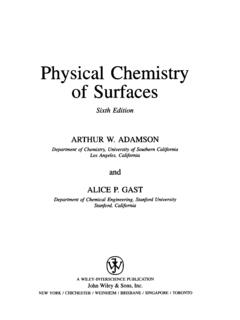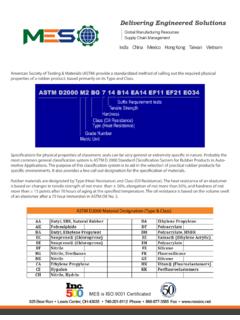Transcription of Standard Test Methods for Determining Average Grain Size
1 Designation: E 112 96e3 Standard Test Methods forDetermining Average Grain Size1 This Standard is issued under the fixed designation E 112; the number immediately following the designation indicates the year oforiginal adoption or, in the case of revision, the year of last revision. A number in parentheses indicates the year of last reapproval. Asuperscript epsilon (e) indicates an editorial change since the last revision or Standard has been approved for use by agencies of the Department of Equations , and were editorially revised in April New numbers were assigned to the adjuncts in February Footnotes 4, 5 and 9 were editorially corrected and footnote 8 was editorially removed in May test Methods of determination of Average Grain size in metallic materials are primarilymeasuring procedures and, because of their purely geometric basis, are independent of the metal oralloy concerned.
2 In fact, the basic procedures may also be used for the estimation of Average Grain ,crystal, or cell size in nonmetallic materials. The comparison method may be used if the structure ofthe material approaches the appearance of one of the Standard comparison charts. The intercept andplanimetric Methods are always applicable for Determining Average Grain size . However, thecomparison charts cannot be used for measurement of individual These test Methods cover the measurement of averagegrain size and include the comparison procedure, the planimet-ric (or Jeffries) procedure, and the intercept procedures.
3 Thesetest Methods may also be applied to nonmetallic materials withstructures having appearances similar to those of the metallicstructures shown in the comparison charts. These test methodsapply chiefly to single phase Grain structures but they can beapplied to determine the Average size of a particular type ofgrain structure in a multiphase or multiconstituent These test Methods are used to determine the averagegrain size of specimens with a unimodal distribution of grainareas, diameters, or intercept lengths. These distributions areapproximately log normal.
4 These test Methods do not covermethods to characterize the nature of these of Grain size in specimens with duplex grainsize distributions is described in Test Methods E 1181. Mea-surement of individual, very coarse grains in a fine grainedmatrix is described in Test Methods E These test Methods deal only with determination ofplanar Grain size , that is, characterization of the two-dimensional Grain sections revealed by the sectioning of spatial Grain size , that is, measurement of thesize of the three-dimensional grains in the specimen volume.
5 Isbeyond the scope of these test These test Methods describe techniques performedmanually using either a Standard series of graded chart imagesfor the comparison method or simple templates for the manualcounting Methods . Utilization of semi-automatic digitizingtablets or automatic image analyzers to measure Grain size isdescribed in Test Methods E These test Methods deal only with the recommended testmethods and nothing in them should be construed as definingor establishing limits of acceptability or fitness of purpose ofthe materials The measured values are stated in SI units, which areregarded as Standard .
6 Equivalent inch-pound values, whenlisted, are in parentheses and may be Standard does not purport to address all of thesafety concerns, if any, associated with its use. It is theresponsibility of the user of this Standard to establish appro-priate safety and health practices and determine the applica-bility of regulatory limitations prior to The paragraphs appear in the following order:SectionNumberScope1 Referenced Documents2 Terminology3 Significance and Use4 Generalities of Application5 Sampling6 Test Specimens7 Calibration8 Preparation of Photomicrographs9 Comparison Procedure101 These test Methods are under the jurisdiction of ASTM Committee E-4 onMetallography and are the direct responsibility of Subcommittee on edition approved May 10, 1996.
7 Published July 1996. Originallypublished as E 112 55 T. Last previous edition E 112 ASTM International, 100 Barr Harbor Drive, PO Box C700, West Conshohocken, PA 19428-2959, United ASTM International Reproduced by IHS under license with ASTM Not for ResaleNo reproduction or networking permitted without license from IHS--````,,-`-`,,`,,`,`,,`---Planimetric (Jeffries) Procedure11 General Intercept Procedures12 Heyn Linear Intercept Procedure13 Circular Intercept Procedures14 Hilliard Single-Circle Three-Circle Analysis15 Specimens with Non-equiaxed Grain Shapes16 Specimens Containing Two or More phases or Constituents17 Report18 Precision and Bias19 Keywords20 Annexes.
8 Basis of ASTM Grain size NumbersAnnexA1 Equations for Conversions Among Various Grain size Measurements AnnexA2 Austenite Grain size , Ferritic and Austenitic SteelsAnnexA3 Fracture Grain size MethodAnnexA4 Requirements for Wrought Copper and Copper-Base AlloysAnnexA5 Application to Special SituationsAnnexA6 Appendixes:Results of Interlaboratory Grain size DeterminationsAppen-dix X1 Referenced AdjunctsAppen-dix X22. Referenced Standards:E 3 Practice for Preparation of Metallographic Specimens2E 7 Terminology Relating to Metallography2E 407 Practice for Microetching Metals and Alloys2E 562 Practice for Determining Volume Fraction by Sys-tematic Manual Point Count2E 691 Practice for Conducting an Interlaboratory Study toDetermine the Precision of a Test Method3E 883 Guide for Reflected-Light Photomicrography2E 930 Test Methods for Estimating the Largest Grain Ob-served in a Metallographic Section (ALA Grain size )
9 2E 1181 Test Methods for Characterizing Duplex GrainSizes2E 1382 Test Methods for Determining Average Grain SizeUsing Semiautomatic and Automatic Image For a complete adjunct list, see Appendix X23. For definitions of terms used in these testmethods, see Terminology E of Terms Specific to This Grain size number the ASTM Grain sizenumber,G, was originally defined as:NAE52G21(1)whereNAEis the number of grains per square inch at 100 Xmagnification. To obtain the number per square millimetre at1X, multiply by that area within the confines of the original(primary) boundary observed on the two-dimensional plane-of-polish or that volume enclosed by the original (primary)boundary in the three-dimensional object.
10 In materials contain-ing twin boundaries, the twin boundaries are ignored, that is,the structure on either side of a twin boundary belongs to boundary intersection count determination ofthe number of times a test line cuts across, or is tangent to, Grain boundaries (triple point intersections are considered as1-1 2intersections). intercept count determination of the number oftimes a test line cuts through individual grains on the plane ofpolish (tangent hits are considered as one half an interception;test lines that end within a Grain are considered as one half aninterception).










